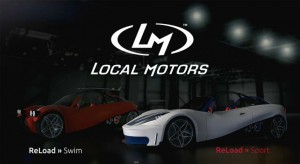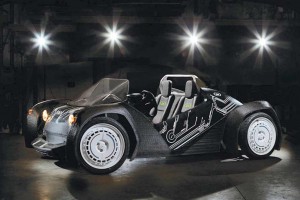Forget making vases, bracelets and other trinkets, Arizona-based Local Motors plans to transform the traditional automotive world with the launch of a 3D printed car next year.
The company plans to build two versions of the ReLoad Redacted using a design that was submitted as part of a contest by Kevin Lo, an engineer living in Vancouver, Washington. Set to debut during the first quarter of 2016, it will be a low-speed battery-car, or so-called neighborhood electric vehicle, priced between $18,000 and $30,000. But a full speed vehicle is set to follow.
“At Local Motors, we are hell-bent on revolutionizing manufacturing,” said John B. Rogers, Jr., CEO and co-founder of Local Motors. “Car manufacturers have been stamping parts the same way for more than 100 years. We now have the technology to make the process and products better and faster by linking the online to the offline through DDM. This process will create better and safer products, and we are doing exactly that.”
Also known as Direct Digital Manufacturing, there are several versions of 3D printing. The most common method uses a laser to form various materials, from epoxy resins to powdered titanium, into solid objects. Local Motors uses a slightly different deposition process that also builds up objects essentially one pixel at a time. Both methods are relatively slow compared to conventional manufacturing but has the advantage of allowing near endless customization.
Local Motors publicly demonstrated its concept at the Detroit Auto Show last January, printing out an entire body on the floor of the Cobo Hall convention center. That prototype, dubbed the Strati, had barely 50 individual parts, beyond the electric powertrain.
Where a traditional automobile is put together, piece by piece, on an assembly line that can be miles long, snaking through a plant that might cost as much as $1 billion to erect and tool up, Local Motors plans to set up a series of compact facilities a fraction of the size and cost.
“Micro-factories are a great counterpoint because they employ an economy of scope by taking advantage of low cost tooling and co-creation,” explained co-founder Rogers last January, “Resulting in the ability to get products to market faster and in less time while using less capital to find a winning concept.”
(Local Motors looking at several 3D factories. Click Here for more.)
Local Motors has been working with the Oak Ridge National Laboratory on 3D printing, which is also referred to as stereo lithography. And it claims to have tapped into a vast, worldwide network of pioneers, some professional, some amateurs, to work out the kinks in 3D printing. That includes contest winner Lo who works for Hewlett-Packard on advanced printer systems.
Among the judges in the contest, comedian and car fanatic Jay Leno, the former Tonight Show host, said, “You need something that makes you go ‘what’s that?’”
(Ford, other automakers also betting big on 3D printing. For more, Click Here.)
While the technology is less expensive and complex than operating an assembly line it also is a lot slower. It currently takes days to print out a car’s body. So, were Local Motors ever to envision going large-scale it might need 100s, even 1,000s of 3D printers. However, research is ongoing and some proponents claim they are working on techniques that could increase printer speeds by as much as 500-fold.
Local Motors has been offering a model dubbed the Rally Fighter for $99,000, and though the private company won’t reveal numbers, industry observers believe sales are measured in double digits, at most. The new project would be the first effort to make something that’s more than a curiosity.
The two initial Local Motors models, the ReLoad Swim and Sport will be priced between $18,000 and $30,000. They will be followed later next year by a 3D printed vehicle homologated – or designed to conform – to meet federal safety standards, the company states.
Meanwhile, it has launched a program it calls LOCO University Vehicles, short for Local Motors Co-Created University Vehicles. Three colleges have already signed up to participate, the University of Michigan, Arizona State University and the University of Nevada at Las Vegas. Several projects will focus on developing an autonomous vehicle.
“Think Uber, but with low-speed, autonomous cars,” said Ed Olson, an associate professor of Electrical Engineering and Computer Science at University of Michigan who leads the project. “The goal of this program is for us to begin to understanding the challenges of a transportation-on-demand system built around autonomous cars.”
The goal is to create a fleet of autonomous vehicles to transport students around Michigan’s North Campus in Ann Arbor.
(Korean carmakers score big gains in auto quality, satisfaction. Click Here for the latest.)



While the 3D tech is useful and evolving, these folks must be reading their own press releases if they think they have a viable product via a 3D printed car. The first clue is they think it’s acceptable to make a one piece body. Think again as this is totally impractical for an auto and most other vehicles. Think crash repair, structural rigidity, assembly, maintenance, and much more.
3D printing most certainly has a lot of potential but to believe that you can build acceptable autos without understanding all of the issues that comprise a buildable, serviceable and functional product is to be naïve.
As far as AV use is concerned we have already discussed many times the huge number of obstacles that need to be resolved before any AV is allowed on the roadways. Research is important but let’s not skip reality in the pie-in-the-sky projections and rush to reap financial fortunes from half-baked AVs. We’ve already seen a dozen accidents with Google’s driver monitored EVs and there have been reports of similar accidents from other AV pioneers. Rushing AVs to market will be a deadly lesson.